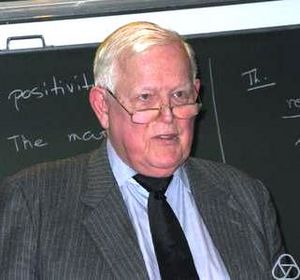Rudolf E. Kálmán facts for kids
Quick facts for kids
Rudolf E. Kálmán
|
|
|---|---|
 |
|
| Born |
Rudolf Emil Kálmán
May 19, 1930 Budapest, Hungary
|
| Died | July 2, 2016 (aged 86) |
| Citizenship | Hungary United States |
| Alma mater | Massachusetts Institute of Technology Columbia University |
| Known for | Kalman filter Kalman problem Kalman decomposition Kalman–Yakubovich–Popov lemma Observability State-space representation |
| Awards | IEEE Medal of Honor (1974) Rufus Oldenburger Medal (1976) Kyoto Prize (1985) Richard E. Bellman Control Heritage Award (1997) Charles Stark Draper Prize (2008) National Medal of Science (2009) |
| Scientific career | |
| Fields | Electrical Engineering Mathematics Applied Engineering Systems Theory |
| Institutions | Stanford University University of Florida Swiss Federal Institute of Technology |
| Doctoral advisor | John Ragazzini |
| Doctoral students |
|
Rudolf Emil Kálmán (May 19, 1930 – July 2, 2016) was a smart Hungarian-American engineer and mathematician. He is most famous for helping create the Kalman filter. This is a special math tool used in many places. It helps things like signal processing, control systems, and guidance, navigation and control work better. Because of his amazing work, U.S. President Barack Obama gave Kálmán the National Medal of Science in 2009.
Contents
Rudolf Kálmán's Life and Career
Rudolf Kálmán was born in Budapest, Hungary, in 1930. His parents were Otto and Ursula Kálmán. In 1943, his family moved to the United States.
Education and Early Work
He studied electrical engineering at the Massachusetts Institute of Technology (MIT). He earned his first degree in 1953 and his master's degree in 1954. Kálmán then got his doctorate degree in 1957 from Columbia University in New York City.
From 1958 to 1964, Kálmán worked as a research mathematician. He was at the Research Institute for Advanced Studies in Baltimore, Maryland.
Teaching and Research Roles
Kálmán became a professor at Stanford University in 1964. He taught there until 1971. After that, he became a professor and director at the University of Florida. He worked there from 1971 to 1992.
He also spent time in France, at MINES ParisTech. From 1973, he held a special position at the Swiss Federal Institute of Technology in Zürich, Switzerland.
Rudolf Kálmán passed away on July 2, 2016, at his home in Gainesville, Florida.
What is the Kalman Filter?
Rudolf Kálmán was an electrical engineer by training. He is best known for creating the Kalman filter. This is a mathematical method used in digital computers.
How the Kalman Filter Works
The Kalman filter helps to find a clear signal from noisy or incomplete information. Imagine you have a lot of measurements that are not perfect. The filter can figure out the true value. It's like finding a clear voice in a room full of chatter.
This filter is used in many important systems. It helps with control systems, navigation systems, and avionics (electronics in aircraft). It's also used in outer-space vehicles. It often works with electronic and gyroscopic systems.
Early Challenges and Success
When Kálmán first shared his ideas, many people were doubtful. He even had to publish his first results in a journal about mechanical engineering. This was because electrical engineering journals were not interested.
However, Kálmán found success when he visited Stanley F. Schmidt at the NASA Ames Research Center in 1960. This meeting changed everything!
Kalman Filter in Space and Beyond
The Kalman filter was then used during the Apollo program. This was the program that sent humans to the Moon! It was also used in the NASA Space Shuttle.
Today, the Kalman filter is still very important. It helps Navy submarines, unmanned aerospace vehicles, and even cruise missiles.
Other Important Contributions
Kálmán also wrote several important papers in the 1960s. These papers helped define how dynamic systems work. He introduced ideas like controllability and observability. These ideas led to the Kalman decomposition.
He also made big contributions to the theory of optimal control. This is about making systems work in the best possible way. He also worked on stability theory, which helps make sure systems are steady and don't go out of control.
Awards and Honors
Rudolf Kálmán received many awards and honors for his work. He was a member of several important science groups. These included the National Academy of Sciences and the National Academy of Engineering in the U.S. He was also a foreign member of the French, Hungarian, and Russian Academies of Sciences.
Major Awards
Some of his top awards include:
- The IEEE Medal of Honor in 1974.
- The Kyoto Prize in Advanced Technology in 1985.
- The Richard E. Bellman Control Heritage Award in 1997.
- The Charles Stark Draper Prize in 2008.
- The National Medal of Science in 2009.
He also received many honorary doctorates from different universities. In 2012, he became a fellow of the American Mathematical Society.
See also
 In Spanish: Rudolf E. Kalman para niños
In Spanish: Rudolf E. Kalman para niños
- Hamilton–Jacobi–Bellman equation

